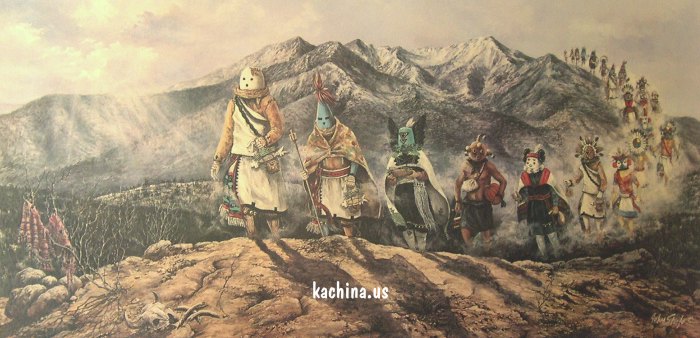|
|
|
The Hopi Kachina CultThe land of the American Southwest is known for its searing desert and towering peaks, but between these extremes are areas suitable for human habitation. The majority of Southwestern Indian tribes are found in the uplands, on the flanks of the high mountains among pinyon pines and juniper. Here, access is easy to both the game of the highlands and to the protein-rich seeds of the desert plants. The Southwestern tribes represent two modes of adaptation: the sedentary people occupying small villages and raising crops; and the nomadic groups that depend on hunting and more recently on the raising of livestock. Often the two occupy the same land, though using it for different purposes. It is the sedentary Indians of Arizona and New Mexico; those dwelling in small communities of tightly packed houses that the Spanish Conquistadors called "pueblos." Farmers in any part of the world have always been dependent on the weather for successful crops, and the Pueblo people have been contending with the vagaries of the Southwest's weather patterns for more than 2,000 years. In the course of that time they have accumulated a store of commonsense observations on what may happen if certain conditions prevail, and with this knowledge has come a relatively accurate system of weather prediction. However, this is really not enough to survive the erratic weather conditions of their semiarid land. And so the Pueblo peoples evolved an elaborate pattern for securing help from the supernatural forces that are believed to control nature. All of the Pueblos have this complex religious pattern, though in some groups it is more elaborate than in others. The Hopi Indians are the westernmost of the Pueblo peoples and live in twelve villages set on the three mesas in northeastern Arizona. These are called First Mesa, Second Mesa and Third Mesa in order of their access from the east. To grow crops, particularly corn in their semiarid land, the Hopis believe it is absolutely essential to have the supernaturals on their side. The Hopis believe that their supernaturals have certain powers which they do not have, and that they in turn possess things which their supernaturals desire. Thus quite often Hopi rituals are mutual gift-giving ceremonies. The supernaturals desire prayer feathers, corn pollen and various rituals, and the Hopis like rain, so this mutual exchange works out very well for both parties. The Kachina cult has been described as a common denominator in Hopi religion. Nearly every Hopi takes part in it, and Kachinas are a popular and much discussed feature of Hopi life. Hopi Kachinas are supernaturals, embodying the spirits of living things and also the spirits of ancestors who have died and become a part of nature. Kachinas are believed to possess powers over nature, especially the weather, but higher gods limit the extent of their powers. There are still other supernaturals in the Hopi pantheon that are not Kachinas, but which affect Kachinas. To Hopis, it is essential to preserve harmony with the world around them, not only with man and other animals but with objects in nature such as rocks, clouds, sky, etc., which the Hopis believe to be possessed of life. Since the Kachinas embody these spirits they are the spiritual guardians of the Hopi people and their way of life. And since they can insure human, animal and plant fertility, they insure life itself. Hopi men carve likenesses of the Kachinas from cottonwood root, and these are the well known Kachina dolls that are of special interest to collectors. In the yearly cycle of religious ceremonies, Kachina dances are preeminent. However, the term "dance" does not have the same meaning as the Western notion of social or interpretive dance. In Hopi dances, the Kachinas are represented by Hopi men, aged ten to eighty. When Kachinas are represented by the men of the villages, they assume visual form and appear in the streets and plazas of the town. It is here that the Kachina is his most magnificent, for the Hopis feel that when they impersonate a Kachina they become the supernatural. As supernaturals they may cure disease, grow corn, bring clouds and rain, watch over ceremonies and reinforce discipline and order in the Hopi world. Because there are many circumstances that arise requiring supernatural help, there are many Kachinas. Among the Hopi there are about 300 Kachinas that may be current, and at least another 200 that may be known but make only sporadic appearances. It is perfectly consistent that Kachinas may wane and new ones appear as the needs of the Hopis change. Thus some Kachinas remain only in appearance, with all thought of their original purpose lost, or some will fade from memory entirely. At the other extreme will be Kachinas that are not more than a few years old. Each Kachina has a particular marking or symbol that identifies it to the Hopi. Less apparent are details of costume that are essential to the different types of Kachinas. There are many Kachinas that represent elements in the world of the Hopi, such as plants, animals, clouds, abstract forms, stars and sky. Everything that surrounds the Hopi may have a supernatural associated with it, and it is thus possible to have an Ashes Kachina or a Jimson Weed Kachina. In addition there are Kachinas that represent the spirit of the Hopi's neighbors, the Navajo or the Zuni, the Havasupai or the Apache. These may be caricatures or earnest representations. One group of Kachinas, the Chief Kachinas, correspond to the village leaders and are most important. They have jurisdiction over other Kachinas and the more important aspects of village life. These Kachinas, which are rather few in number, are never changed and appear at every important ceremony with which they are connected. There is another group of Kachinas that might be described as warriors or guards. They oversee the handling of particular events, making sure that the audience does not approach the wrong area or interfere with the dancers. Some of them serve to enforce community projects, insuring that Hopi men attend and perform their duties. Others bear war symbolism which refers back in time to the period when the Hopis were under attack by hostile neighbors. Although the Hopis are considered peaceful, the necessity for defense in the past is commemorated in the spears carried by certain Kachinas, in the designs symbolizing bravery, and in particular Kachinas such as the Warrior Maid who saved her village when it was under attack. The Kachina calendar begins with the appearance of the important Kachinas in January. At this time Chief Kachinas bless certain portions of the village and perform rituals designed to open the season for other Kachina performances. The second major ceremony--Powamu--occurs in February and is accompanied by the magical appearance of green growing plants while the land is still locked in the grip of winter. At Powamu or "Bean Dance" large numbers of Kachinas appear but usually do not dance. At times when the young men of the village are initiated into the tribe (not to be confused with the annual initiation of the children into the Kachina cult), the Powamu ceremony may be even larger, and rarer Kachinas make their appearance. In March, the Night Dances are held in the kivas, for it is still too cold to dance in the plaza. These dances are generally similar to the Plaza Dances which are held later in the spring. Plaza Dances are composed of line dancers, with many performers representing a single Kachina or a mixed group of similar figures. The greater amount of space in the plaza provides room for the long lines of regular dancers and for the more active "side dancers." These highly skilled "side dancers" encourage the others and emphasize the rhythm of the song and often accompany the words of the songs with gestures. Summer dances are always popular and well attended. The final dance of the year is the "Home Dance" or Niman. It signals the departure of all the Kachinas for their mountain homes. After the "Home Dance" no more Kachinas appear until the following year. The Kachinas, then, occupy much of the ceremonial year. They distribute food and blessings, accept prayers, provide entertainment, and reflect many features of Hopi life. In addition, there are many important family relationships among the Kachinas. The women (Kachin-mana) are sisters or wives of the male dancers. Kachinas may have aunts, uncles or grandfathers so that life among the supernaturals seems to emphasize the order of a Hopi family. In the Kachina dances, the Kachina women (normally impersonated by men), grind corn in a ritual enactment by the use of rasps and gourd resonators, and this is accompanied by the Kachina men's distribution of food. In this giving, the farmers' produce is shared by the entire community. During the day, the villagers often feast in various relatives' homes, enjoying themselves and reinforcing their ties of family and clan kinship. Thus, entertainment, discipline, teaching, explanations of nature and reflections of the Hopi past all blend together in the Kachina cult. In fact, the many different aspects of Kachinas and their flexibility help explain their importance and popularity.
HomeThe Hopi Kachina CultAholi KachinaBear KachinaClown KachinaCrow MotherEagle KachinaEototo KachinaFox KachinaKokopelli KachinaMorning Singer KachinaMudhead KachinaSnow KachinaSun KachinaWolf KachinaWupamo Kachina
|

